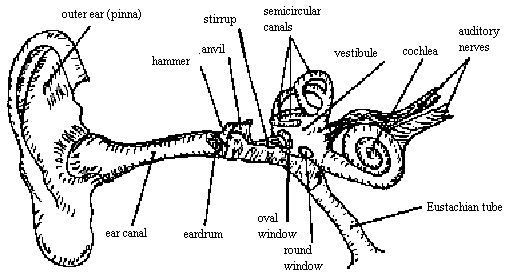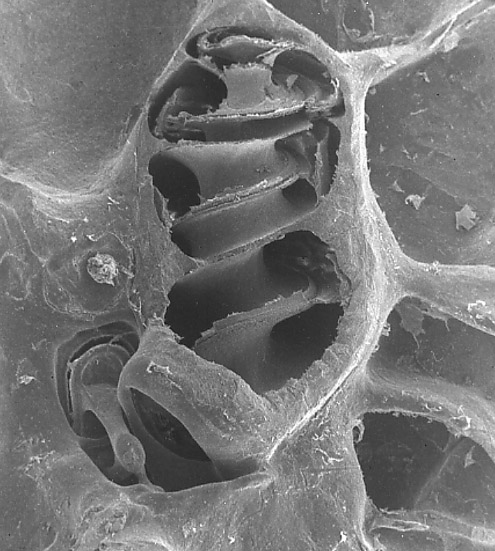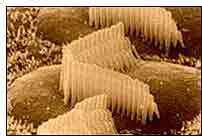Human Hearing

Here are two animations that explain how the ear works:
http://www.nebraskamed.com/health-library/3d-medical-atlas/291/anatomy-of-the-ear
http://www.nebraskamed.com/health-library/3d-medical-atlas/304/hearing
(These videos are linked to from this index page which also has some other videos you might find interesting.)
Above is a diagram of the human hearing system. Know the parts and how they interact: Incoming sound waves are funneled into the ear canal by the outer ear (or pinna), the part that sticks off our heads. The ear canal itself is about 2 cm long and is capped by the eardrum, a thin membrane about a centimeter in diameter, but only a few cells thick. It vibrates like the head of a (musical) drum when the sound waves hit it. Connected to the eardrum are three bones, the hammer, anvil, and stirrup, which transmit the vibrations of the eardrum to the oval window of the cochlea, a fluid-filled structure that looks a bit like a snail's shell. The purpose of those three bones is also to amplify — the pressure of the stirrup on the oval window is 22 times greater than the pressure of the sound waves on the eardrum.


(right) The cochlea of a chinchilla. Credit: Auditory Science Lab at The Hospital for Sick Children, University of Toronto, Canada
The vibrations of the oval window cause waves in the fluid inside the coclea. Along the inside walls of the cochlea there are about 16,000 hairs sticking into the fluid. When the fluid wave goes by, the hair cells wave back-and-forth. These hair cells are a kind of nerve cell: when wiggled, the hair cell sends an electrical signal to the brain via a bundle of other nerve fibers (the auditory nerves). The longer hair cells near the oval window respond to low-frequency sound; the far end of the cochlea channel, where it is narrow and the hairs short, is where high-frequency sounds are sensed. As you've already learned, the cochlea can detect sounds from about 20 Hz to 20 kHz in frequency.
The round window acts to dampen (decrease) the waves so they don't keep echoing inside the cochlea.
The Eustachian tube is a thin air passage to the pharynx. This allows the air pressure in the middle ear (the area from the eardrum to the oval window) to equalize with the surrounding atmospheric pressure.
Our hearing is damaged by very loud sounds. Extremely loud sounds cause such strong waves in the cochlear fluid that the hair cells aren't just swished around, but are instead ripped off of the walls of the cochlea. Once gone, they do not grow back — damage adds up. That's why older people are often hard of hearing.


Above left: undamaged cochlear hair cells. Above right: closeup of hair cell damage after listening to 105-125dB music for 3 hours.
Ringing in the ears is called tinnitus. Physiologists don't know why it happens.
In summertime the oval window is replaced with the oval screen.
One benefit of having two ears is that we can locate the general direction from which a sound is coming. If a sound is detected by the right ear before the left ear hears it, then the sound must be coming from the right somewhere, because the sound takes more time to get to the opposite ear. Stereo sound systems exploit this to create the illusion of realistic sound from only two speakers.
I was just kidding about the oval screen.
Activities & Practice
to do as you read.
Some companies are now marketing ultrasonic cellphone ringtones to teenagers. Most people older than 20 years can't hear sounds higher than about 17 kHz. What are the (a) period and (b) wavelength of 17 kHz sound?